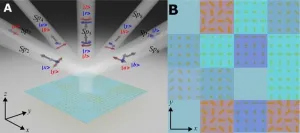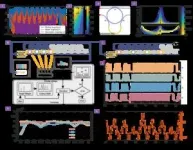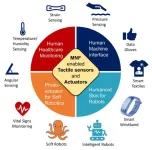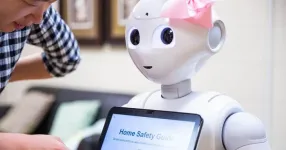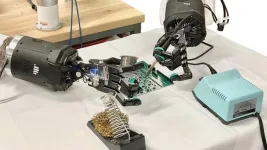A new publication from Opto-Electronic Advances; DOI 10.29026/oea.2024.240076 , discusses spin-controlled generation of a complete polarization set with randomly-interleaved plasmonic metasurfaces.
Optical metasurfaces are finely crafted two-dimensional artificial nanostructures composed of meticulously designed arrays of ultrathin artificial atoms. These surfaces possess capabilities beyond natural materials, enabling multifunctional control of electromagnetic waves. By designing the shape, size, rotation, and position of these artificial atoms, optical metasurfaces can precisely manipulate electromagnetic waves at subwavelength spatial resolutions, offering vast potential applications in the field of photonics.
Among the many applications, the control of polarization states using optical metasurfaces has been extensively studied. The development of polarization-encoded multifunctional metasurfaces represents a significant leap in optical technology, allowing a wider range of functions to be integrated into a single metasurface. This polarization encoding integration is achieved through innovative artificial atom designs and the clever interweaving of different metasurface regions, heralding a new era in photonics. Metasurfaces, as multipurpose platforms for various optical applications, exemplify the ongoing progress towards more integrated and dynamically controllable optical components.
Despite significant advancements in polarization state control using optical metasurfaces, most current metasurfaces are limited to generating a few specific polarization states distributed across a limited number of channels. Methods for controllably generating a full set of polarization states (e.g., left- and right-handed circularly polarized light, and linearly polarized light in different orientations) across multiple channels, as well as techniques for achieving switchable polarization states within different channels, have been rarely reported to date.
To address these challenges, the authors of this article proposed a reflective gold-silica-gold plasmonic metasurface. This innovative design features six randomly interleaved metasurface regions, each capable of outputting and collecting different polarization states at distinct reflection angles simultaneously. This design method allows for multi-directional beam control across all polarization channels and enables polarization state changes in the output channels by switching the spin state of the incident circularly polarized light.
The design includes a nanobrick-shaped half-wave plate and four nano-cross-shaped quarter-wave plates. The half-wave plate can convert left-handed circularly polarized light to right-handed circularly polarized light, or vice versa. By rotating the half-wave plate in 45° increments, a geometric phase gradient is produced, separating the reflection angles of light with the same polarization state as the incident circularly polarized light. The quarter-wave plates, rotated at specific angles, can transform incident circularly polarized light into linearly polarized light at different angles. These plates provide a linear phase gradient, converting circularly polarized light into linearly polarized light at orientations of 0°, 45°, 90°, and 135°, which are then reflected at different angles.
By integrating these nanoscale plates and designing them with different rotational angles, the metasurface can achieve simultaneous output of a full set of polarization states across multiple channels. Utilizing the advanced micro- and nano-fabrication and characterization platforms at the Centre for Nano Optics at the University of Southern Denmark, the researchers experimentally validated their metasurface design.
This research marks a significant advancement in the field of polarization optics and paves the way for the development of compact, efficient, and powerful optical devices. The unique properties of these nanoscale wave plates open new avenues for applications ranging from imaging and sensing to communication and other advanced optical technologies. The potential impact of this technology is immense, promising a bright future for the realization of complex optical systems that can be dynamically controlled, thereby enhancing the versatility and performance of optical components across various disciplines.
Keywords: plasmonic metasurface / randomly interleaved / multidirectional beam-steering / spin-controlled / all-polarization generation
# # # # # #
The Centre for Nano Optics at the University of Southern Denmark (SDU Nano Optics, https://www.sdu.dk/en/forskning/nanooptics) is a leading research center dedicated to exploring the interaction between light and matter at the nanoscale. Led by Prof. Sergey I. Bozhevolnyi, the center focuses on several key research directions, including plasmonics, metasurfaces, and quantum nanophotonics. These areas of study aim to harness the unique properties of light for applications in optical communication, sensing, and imaging technologies. The research team at SDU Nano Optics comprises a diverse group of scientists and engineers, including Prof. Sergey I. Bozhevolnyi, Assoc. Prof. Prof. Fei Ding, Assoc. Prof. Jonas Beermann, Asst. Prof. Shailesh Kumar, Asst. Prof. Vladimir Zenin, and numerous postdoctoral researchers and PhD students. Their combined expertise spans various disciplines, enabling groundbreaking work in the design, fabrication, and characterization of nanostructures. Equipped with state-of-the-art facilities, the center boasts advanced fabrication equipment, such as electron beam lithography and focused ion beam systems, as well as cutting-edge optical measurement tools. These resources allow for the precise creation and analysis of nanoscale devices, essential for pushing the boundaries of current optical technologies. SDU Nano Optics has a prolific publication record, with numerous articles in high-impact journals such as Nature Communications, Science Advances, Reports on Progress in Physics, Light: Science & Applications, and ACS Nano. These publications reflect the center's commitment to advancing the field of nano-optics and its contributions to the scientific community.
# # # # # #
Opto-Electronic Advances (OEA) is a rapidly growing high-impact, open access, peer reviewed monthly SCI journal with an impact factor of 15.3 (Journal Citation Reports for IF2023). OEA has been indexed in SCI, EI, DOAJ, Scopus, CA and ICI databases, and expanded its Editorial Board to 31 members from 17 countries with an average h-index of 62.
The journal is published by The Institute of Optics and Electronics, Chinese Academy of Sciences, aiming at providing a platform for researchers, academicians, professionals, practitioners, and students to impart and share knowledge in the form of high quality empirical and theoretical research papers covering the topics of optics, photonics and optoelectronics.
# # # # # #
More information: http://www.oejournal.org/oea
Editorial Board: http://www.oejournal.org/oea/editorialboard/list
All issues available in the online archive (http://www.oejournal.org/oea/archive).
Submissions to OEA may be made using ScholarOne (https://mc03.manuscriptcentral.com/oea).
ISSN: 2096-4579
CN: 51-1781/TN
Contact Us: oea@ioe.ac.cn
Twitter: @OptoElectronAdv (https://twitter.com/OptoElectronAdv?lang=en)
WeChat: OE_Journal
# # # # # #
im Sande S, Deng YD, Bozhevolnyi SI et al. Spin-controlled generation of a complete polarization set with randomly-interleaved plasmonic metasurfaces. Opto-Electron Adv 7, 240076 (2024). doi: 10.29026/oea.2024.240076
END
